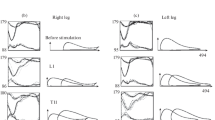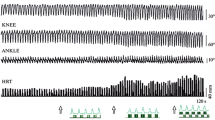Abstract
A novel approach was designed to regulate the stepping movements in human by means of noninvasive electrical transcutaneous spinal cord stimulation (TSCS) to activate the flexor/extensor motor pools of the lower limbs in the gait cycle. Selective stimulation was delivered automatically based on signals from gyroscope sensors, which served to detect the stance and swing phases. The initiation of hip extension was a trigger for stimulating extensor pools (L1) during the stance phase, and the initiation of hip flexion was a trigger for stimulating flexor motor pools (T11) during the swing phase. In healthy subjects (n = 6) walking on a treadmill, stimulation at L1 with a frequency of 15 Hz decreased the duration of stance phase by 4% (p = 0.0457), increased the amplitude of movements in the hip joint by 11% (p = 0.0266), decreased the movement amplitude in the ankle joint by 17% (p = 0.0081), and increased EMG activities of the extensors vastus lateralis (VL) (by 31%, p = 0.0441) and gastrocnemius medialis (GM) (by 17%, p = 0.0465) and flexors biceps femoris (BF) (by 26%, p = 0.4637) and tibialis anterior (TA) (by 21%, p = 0.0215) relative to walking without stimulation. Stimulation at Т11 with a frequency of 30 Hz reduced the stance phase duration by 3% (p = 0.0318) and increased the amplitude of movements in the hip joint by 12% (p = 0.0467), the knee lifting by 25% (p = 0.0001), and the terminal anthropometric point height above the surface of support by 19% (p = 0.0001). The changes were accompanied by increases in muscle activities of the flexors BF (by 18%, p = 0.230) and TA (by 14%, p = 0.0170). The reciprocity coefficient decreased in thigh muscles by 15% (p = 0.0301) and increased in shin muscles by 5% (p = 0.0452). Alternating spatiotemporal stimulation at L1 and T11 did not significantly change the durations of the gait cycle and its phases, but changed the kinematic characteristics of movements. The amplitude of movements in the hip joint increased in the stance phase. In the swing phase, higher values were observed for the amplitude of movements in the hip joint, the knee lifting, and the terminal anthropometric point height above the surface of support. EMG activities of thigh and shin muscles increased during stimulation at L1 + T11. EMG activity of extensors was higher than that of flexors in the stance phase, while flexor EMG activity exceeded extensor activity in the swing phase. Thus, the data obtained show the possibility of TSCS selectively to activate the motor pools of the lower extremities, and control their activity to regulate the phases of the stepping cycle during human locomotion.





Similar content being viewed by others
REFERENCES
Mikhailova, E.A., Kozlov, V.A., Ershov, V.Yu., and Gorodnichev, R.M., Enhancement of running swinging efficiency via transcutaneous electrical stimulation of spinal cord, Teor. Prakt. Fiz. Kul’t., 2015, no. 6, p. 29.
Gerasimenko, Y.P., Gorodnichev, R., Machueva, E., et al., Novel and direct access to the human locomotor spinal circuitry, J. Neurosci., 2010, vol. 30, no. 10, p. 3700.
Gerasimenko, Y.P., Lu, D.C., Modaber, M., et al., Noninvasive reactivation of motor descending control after paralysis, J. Neurotrauma, 2015, vol. 32, no. 24, p. 1968.
Sayenko, D.G., Rath, M., Ferguson, A.R., et al., Self-assisted standing enabled by non-invasive spinal stimulation after spinal cord injury, J. Neurotrauma, 2019, vol. 36, no. 9, p. 1435.
Solopova, I.A., Sukhotina, I.A., Zhvansky, D.S., et al., Effects of spinal cord stimulation on motor functions in children with cerebral palsy, Neurosci. Lett., 2017, vol. 639, p. 192.
Ward, A.R., Electrical stimulation using kilohertz-frequency, Alternating Curr. Phys. Ther., 2009, vol. 89, no. 2, p. 181.
Benavides, F.D., Jo, H.J., Lundell, H., et al., Cortical and subcortical effects of transcutaneous spinal cord stimulation in humans with tetraplegia, J. Neurosci., 2020, vol. 40, no. 13, p. 2633.
Kendall, F.P., Kendall McCreary, E., Provance, P.G., et al., Muscles: Testing and Function with Posture and Pain, Baltimore, MD: Williams & Wilkins, 2005, 5th ed.
Sharrard, W.J., The segmental innervation of the lower limb muscles in man: Arris and Gale lecture delivered at the Royal College of Surgeons of England on 2nd January 1964, Ann. R. Coll. Surg. Engl., 1964, vol. 35, no. 2, p. 106.
Wagner, F.B., Mignardot, J.-B., Goff-Mignardot, C.G., et al., Targeted neurotechnology restores walking in humans with spinal cord injury, Nature, 2018, vol. 563, p. 65.
Grishin, A.A., Moshonkina, T.R., Solopova, I., et al., A five-channel noninvasive electrical stimulator of the spinal cord for rehabilitation of patients with severe motor disorders, Biomed. Eng., 2017, vol. 50, no. 5, p. 300.
Komantsev, V.N. and Zabolotnykh, V.A., Metodicheskie osnovy klinicheskoi elektroneiromiografii (Fundamentals of Clinical Electroneuromyography), St. Petersburg: Lan’, 2001.
Dimitrijevic, M.R., Gerasimenko, Y., and Pinter, M.M., Evidence for a spinal central pattern generator in humans, Ann. N.Y. Acad. Sci., 1998, vol. 860, p. 360.
Bussel, B., Roby-Brami, A., Azouvi, P., et al., Myoclonus in a patient with spinal cord transection. Possible involvement of the spinal stepping generator, Brain, 1988, vol. 111, no. 5, p. 1235.
Dietz, V., Central pattern generator, Paraplegia, 1995, vol. 33, no. 12, p. 739.
Gerasimenko, Y.P., Avelev, V.D., Nikitin, O.A., and Lavrov, I.A., Initiation of locomotor activity in spinal cats by epidural stimulation of the spinal cord, Neurosci. Behav. Physiol., 2003, vol. 33, no. 3, p. 247.
Minassian, K., Persy, I., Rattay, F., et al., Posterior root-muscle reflexes elicited by transcutaneous stimulation of the human lumbosacral cord, Muscle Nerve, 2007, vol. 35, no. 3, p. 327.
Gurfinkel, V.S., Levik, Y.S., Kazennikov, O.V., and Selionov, V.A., Locomotor-like movements evoked by leg muscle vibration in humans, Eur. J. Neurosci., 1998, vol. 10, no. 5, p. 1608.
Gorodnichev, R.M., Pivovarova, E.A., Pukhov, A.M., et al., Transcutaneous electrical stimulation of the spinal cord: non-invasive tool for activation of locomotor circuitry in human, Hum. Physiol., 2012, vol. 38, no. 2, p. 158.
Musienko, P., Courtine, G., Tibbs, J.E., et al., Somatosensory control of balance during locomotion in decerebrated cat, J. Neurophysiol., 2012, vol. 107, no. 8, p. 2072.
Ladenbauer, J., Minassian, K., Hofstoetter, U.S., et al., Stimulation of the human lumbar spinal cord with implanted and surface electrodes: a computer simulation study, IEEE Trans. Neural Syst. Rehabil. Eng., 2010, vol. 18, no. 6, p. 637.
Danner, S.M., Hofstoetter, U.S., Ladenbauer, J., et al., Can the human lumbar posterior columns be stimulated by transcutaneous spinal cord stimulation? A modeling study, J. Artif. Organs, 2011, vol. 35, no. 3, p. 257.
Sayenko, D.G., Atkinson, D.A., Dy, C.J., et al., Spinal segment-specific transcutaneous stimulation differentially shapes activation pattern among motor pools in humans, J. Appl. Physiol., 2015, vol. 118, no. 11, p. 1364.
ACKNOWLEDGMENTS
We are grateful to N.D. Shandybina for help in analyzing EMGs.
Funding
This work was supported by the project “Development of a Neurostimulatory Device for Regulating Motor Functions in Patients with Sequels of an Acute Cerebrovascular Event” (a grant for cooperation with OOO Cosyma no. 2/2019 dated December 1, 2019) and the program “Basic Research for Long-Term Development and Competitiveness of the Society and State” (project no. AAAA-A18-118050890115-9).
Author information
Authors and Affiliations
Corresponding author
Ethics declarations
Conflict of interests. The authors declare that they have no real or potential conflict of interest.
Statement of compliance with standards of research involving humans as subjects. All procedures performed in studies involving human participants were in accordance with the ethical standards of the 1964 Helsinki Declaration and its later amendments and were approved by the local Ethics Committee at the Velikie Luki State Academy of Physical Education and Sports (Velikie Luki). All individual participants involved in the study voluntarily gave their written informed consent for participation after being informed about the potential risks and benefits and nature of the study.
Additional information
Translated by T. Tkacheva
Rights and permissions
About this article
Cite this article
Gorodnichev, R.M., Pukhov, A.M., Moiseev, S.A. et al. Regulation of Gait Cycle Phases during Noninvasive Electrical Stimulation of the Spinal Cord. Hum Physiol 47, 60–69 (2021). https://doi.org/10.1134/S0362119721010059
Received:
Revised:
Accepted:
Published:
Issue Date:
DOI: https://doi.org/10.1134/S0362119721010059




